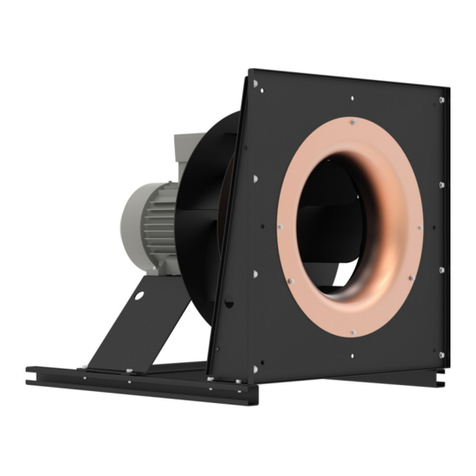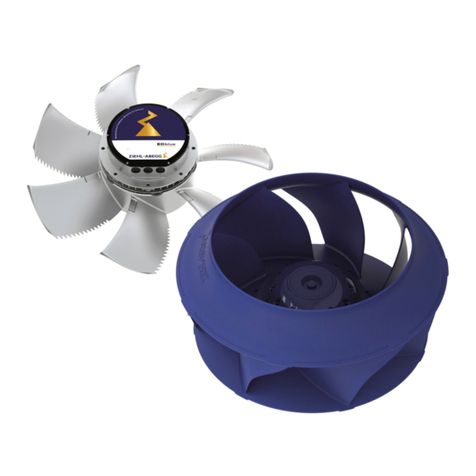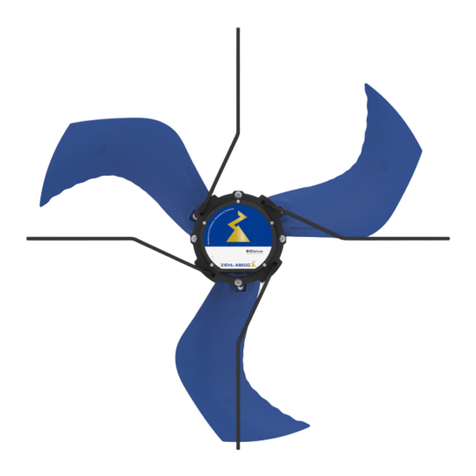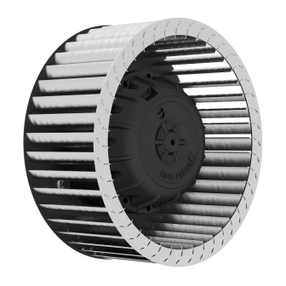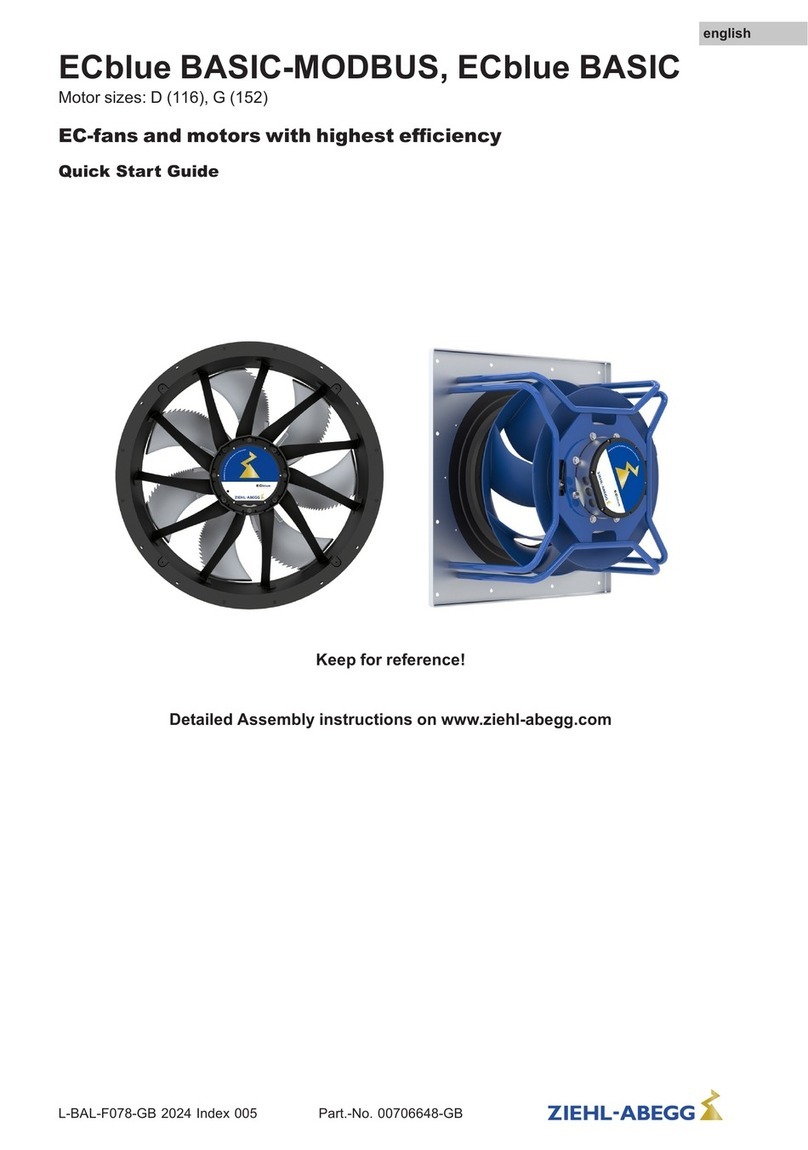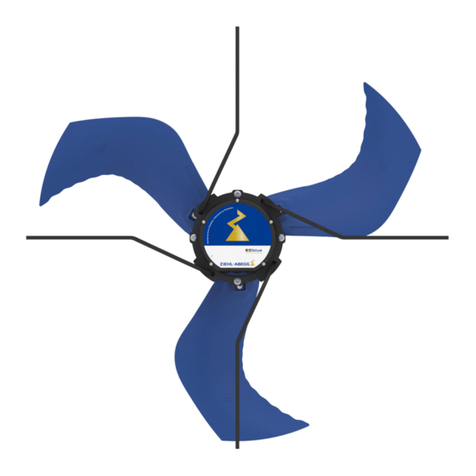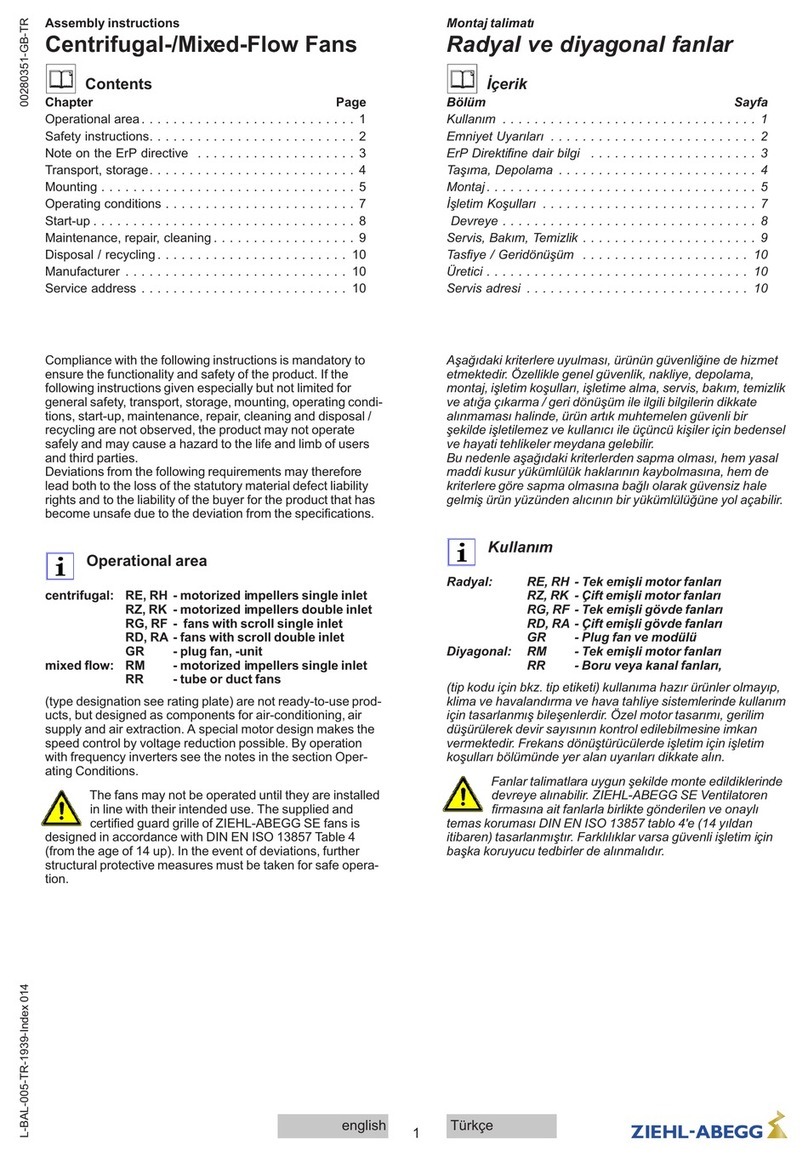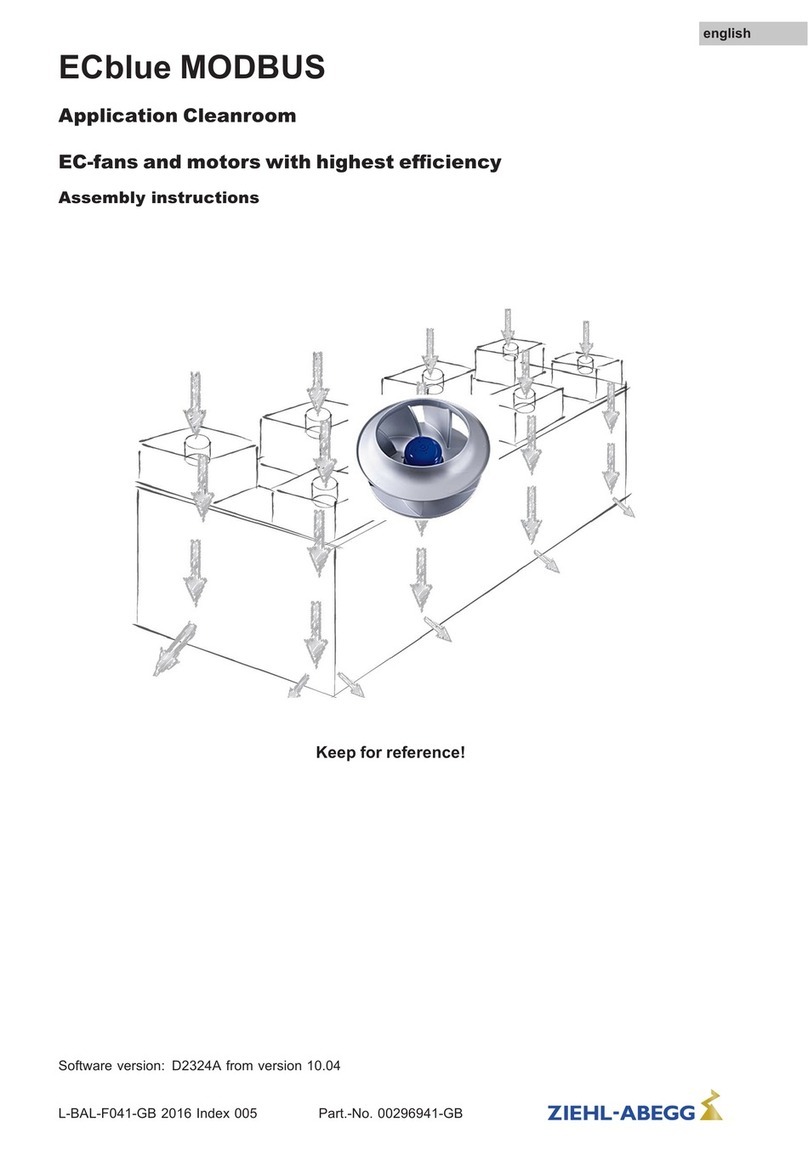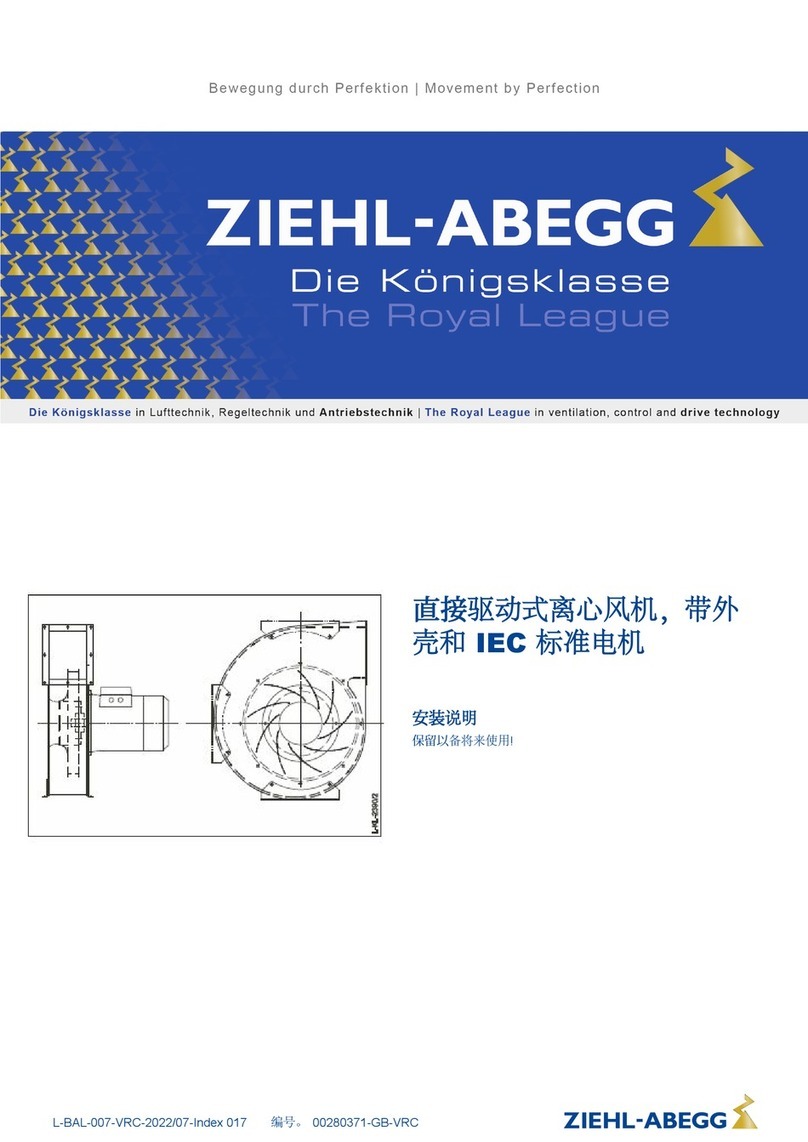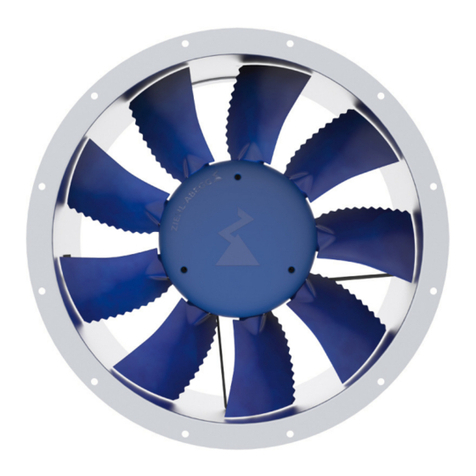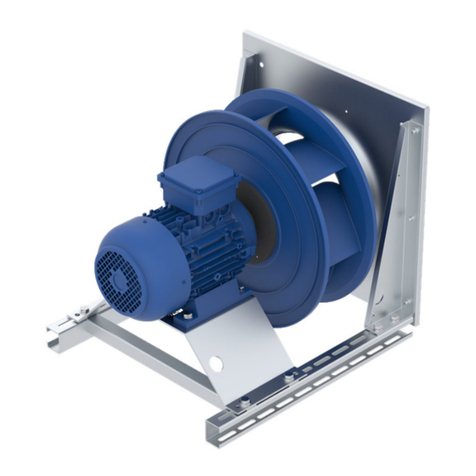schutzart Ex de IIC T4 Gb oder Ex d IIC T4 Gbsind keine
gebrauchsfertigen Produkte, sondern als Komponenten für
Klima-, Be- und Entlüftungsanlagen konzipiert. Sie dürfen
erst betrieben werden, wenn sie ihrer Bestimmung
entsprechend eingebaut sind und die Sicherheit durch
Schutzeinrichtungen nach DIN EN ISO 13857 / EN 60529
und die nach EN 14986 erforderlichen baulichen Explo-
sionsschutzmaßnahmen sichergestellt ist.
•Der Anlagenbauer ist für die Abdichtung der Anlage
verantwortlich.
•Die Ventilatoren erfüllen hinsichtlich der Werkstoffwahl
durch besondere Schutzmaßnahmen im Bereich mögli-
cher Berührungsflächen zwischen rotierenden und
stehenden Bauteilen (Lüfterraddeckscheibe / Einström-
düse) die Anforderungen der Norm EN14986. Für das
rotierende Teil (Lüfterraddeckscheibe) wird als Werkstoff
„Stahl beschichtet“ eingesetzt. Für die Auswahl des Werk-
stoffs der feststehenden Peripherieteile ist, bei Bezug des
Lüfterrades ohne ZIEHL-ABEGG-Einströmdüse, der Anla-
genbauer verantwortlich. Es dürfen nur Werkstoffpaa-
rungen nach EN 14986 eingesetzt werden.
Sicherheitshinweise
•Die Laufräder sind nur zur Förderung von Luft oder explo-
sionsfähiger Atmosphäre der Zone 1 Kategorie 2G und
Zone 2 Kategorie 3G bestimmt. Die Förderung von Fest-
stoffen oder Feststoffanteilen im Fördermedium ist nicht
zulässig.
•Betreiben Sie den Ventilator nur nach seiner bestim-
mungsgemäßen Verwendung und nur bis zur max. zuläs-
sigen Betriebsdrehzahl gemäß Angaben auf dem Venti-
lator-/Laufrad-Typenschild. Ein Überschreiten der max.
zul. Betriebsdrehzahl führt als Folge der hohen kinetischen
Energie (Masse x Drehzahl) zu einer Gefährdungssitua-
tion. Das Laufrad kann bersten - Lebensgefahr! Die
max. zulässigen Betriebsdaten auf dem Typenschild
gelten für eine Luftdichte ρ 1,2 kg/m
3
.
•Freilaufende Laufräder sowie die Gerätebaureihe ER...
dürfen mit Frequenzumrichter nur dann betrieben werden,
wenn ein Antriebsmotor der Zündschutzart „Druckfeste
Kapselung Ex de IIC oder Ex d IIC“ verwendet wird.
•Die Angabe der Temperaturklasse auf dem EX-Prüfschild
(Motor) muss mit der Temperaturklasse des möglicher-
weise auftretenden brennbaren Gases übereinstimmen.
•Montage und elektrische Installation darf nur durch geeig-
netes Fachpersonal, das die einschlägigen Vorschriften
beachtet, vorgenommen werden!
•Jedem Motor muss ein Motorschutzschalter vorgeschaltet
sein. Beachten Sie hierzu die Angaben des Motorherstel-
lers.
•Wicklungsüberwachung durch Kaltleiter für Abschaltung
am Umrichter. Zur Schutzeinrichtung wird ein Auslöse-
gerät mit Kennzeichen II (2) G benötigt.
•Bei Drehzahlsteuerung durch Frequenzumrichter ist
sicherzustellen, dass die max. zul. Drehzahl nicht durch
eine Fehlfunktion des Frequenzumrichters überschritten
wird.
•Bei Betrieb mit Frequenzumrichter ist eine Übermodulation
nicht zulässig. Lüfterrad kann bersten - Lebensgefahr!
•Bezüglich Drehzahlregelung mit Frequenzumrichter sind
die Sicherheitshinweise und Empfehlungen gemäß der
Betriebsanleitung des Motorherstellers einzuhalten. Dies
gilt auch in Bezug auf Motoreinbau, elektrischen
Anschluss und Wartung.
•Beachten Sie die Einbau- und Sicherheitshinweise zu den
verschiedenen Ventilatorbauformen. Nichtbeachtung oder
Missbrauch kann zu körperlichen Schäden oder Beschädi-
gung des Ventilators und zur Explosion einer zündfähigen
Gas-Luftatmosphäre führen - Lebensgefahr.
•Beachten Sie die Hinweise in der Betriebsanleitung des
Motorherstellers, die Bestandteil des Lieferumfangs ist.
•Wird der Ventilator frei ansaugend oder frei ausblasend
eingesetzt, ist zu prüfen, ob die Sicherheitsabstände
gemäß DIN EN ISO 13857 / EN 60529 eingehalten
werden.
•Die Einhaltung der Norm DIN EN ISO 13857 / EN 60529
bezieht sich nur auf den montierten Berührschutz, sofern
dieser zum Lieferumfang gehört.
•Achten Sie insbesondere saugseitig auf ausreichend
bemessenen Sicherheitsabstand, da durch die Sogwir-
kung des Ventilators Kleidung, Gliedmaßen oder bei
größeren Ventilatoren auch Personen angesaugt werden
können.
as components for air-conditioning and ventilation plants.
They may only then be operated when they are installed in
accordance with their intended use and safety has been
ensured through protective devices in accordance with
DIN EN ISO 13857 / EN 60529 and the required structural
explosion-protective measures in accordance with the EN
14986.
•The system constructor is responsible for the sealing of
the system.
•Regarding the choice of materials, the fans fulfill the
requirements of the EN14986 standard through special
protective measures in the area of possible accidental
contact between the rotating and stationary component
parts (impeller). „Coated steel“ is used as the material for
the rotating part (impeller shroud). The system constructor
is responsible for the selection of the material for the
stationary periphery parts when the impeller is purchased
without ZIEHL-ABEGG inlet rings. Only mating materials in
accordance with the EN14986 may be utilized.
Safety instructions
•The impellers are only intended for the conveyance of air
or zone 1 category 2G and zone 2 category 3G explosive
atmospheres. The conveyance of solid matter or solids
content in the conveyance medium handled is not
permitted.
•Only operate the fan according to the intended application,
and only up to the maximum permissible speed given in
the information on the fan/impeller rating plate. Exceeding
the maximum permissible speed leads, as a result of the
high kinetic energy (mass x rotation rate), to a hazardous
situation. The impeller can burst - lethal hazard! The
maximum permissible operating data given on the rating
plate is valid at an air density ρ 1.2 kg/m
3
.
•Impellers without housing/plug fans as well as the ER...
device series may only then be operated with a frequency
converter if a drive motor of the "Ex de IIC or Ex d IIC
pressure-proof housing" ignition protection type is
utilized.
•The data concerning the temperature class on the EX-
rating plate (motor) must coincide with the temperature
class of any possibly occurring combustible gasses.
•Mounting and electrical installation may only be carried out
by trained specialized personnel who observe the relevant
regulations!
•A protective motor switch must be connected before each
motor. Please comply with the motor manufacturer's
instructions.
•Winding monitoring through PTC thermistors for discon-
nection at the converter. A triggering device with the II (2)
G mark is needed as a safeguard.
•In case of speed control through a frequency converter, it
must be ensured that the max. permissible speed cannot
be exceeded due to any frequency converter malfunction.
•When in operation with a frequency converter, no over-
modulation is allowed. The fan wheel may burst – danger
to life!
•With regard to speed regulation with frequency converters,
the safety instructions and recommendations are to be
maintained in accordance with the motor manufacturer’s
operating instructions. This also applies to motor installa-
tion, electrical connections, and servicing.
•Observe the installation and safety instructions applicable
to the various fan designs. Non-observance or misuse can
lead to bodily harm or damage to the fan and to the
explosion of ignitable gas-air mixtures - Danger of death.
•Observe the notes in the motor manufacturer’s operating
instructions, which form part of the supply.
•If a fan is utilized as a free inlet or free discharge type,
verify that the required clearance based on DIN EN ISO
13857 / EN 60529 is maintained.
•The maintenance of the standard DIN EN ISO 13857 / EN
60529 relates only to the installed accidental contact
protection, provided that it is part of the scope of delivery.
•Pay special attention that there is sufficiently dimensioned
safety clearance on the inlet side, as clothes, limbs, or, in
the case of large fans, even people can be sucked in due
to the fan’s suction power.
2englishdeutsch
00282064L-BAL-019-GB-2718-Index 012
